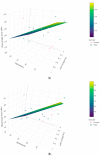Investigation of Antihypertensive Properties of Chios Mastic via Monitoring microRNA-21 Expression Levels in the Plasma of Well-Controlled Hypertensive Patients
- PMID: 38921830
- PMCID: PMC11207086
- DOI: 10.3390/ncrna10030033
Investigation of Antihypertensive Properties of Chios Mastic via Monitoring microRNA-21 Expression Levels in the Plasma of Well-Controlled Hypertensive Patients
Abstract
Hypertension is a chronic, multifactorial disease, leading to high cardiovascular morbidity and mortality globally. Despite the advantages of pharmaceutical treatments, natural products have gained scientific interest due to their emerging phytotherapeutic properties. Chios mastic is a natural Greek product, consisting of bioactive compounds which modify microRNAs' (small, expression-regulating molecules) expression. In this study, we investigated the antihypertensive properties of Chios mastic through the assessment of miR-21 levels. Herein, plasma samples of 57 individuals with hypertension, recruited for the purposes of the HYPER-MASTIC study, were analyzed. This was a clinical trial with Chios mastic supplements in which the patients were divided into groups receiving high and low mastic doses and placebo supplements, respectively. miR-21 was significantly upregulated in patients compared to normotensive individuals. Mean changes in miR-21 levels were statistically significant, after adjusting for sex and age, between the placebo and low-dose group and between the low- and high-dose group. Post-intervention miR-21 levels were positively associated with night-time systolic blood pressure, pulse pressure, and central systolic mean arterial pressure and negatively associated with night-time pulse wave velocity in the low-dose group. Our findings suggest a potential implication of miR-21 in the association of Chios mastic with night-time blood pressure measurements.
Keywords: Chios mastic; biomarker; epigenetics; hypertension; microRNA-21.
Conflict of interest statement
The authors declare no conflicts of interest.
Figures



Similar articles
-
Traditional uses, phytochemistry and pharmacology of Chios mastic gum (Pistacia lentiscus var. Chia, Anacardiaceae): A review.J Ethnopharmacol. 2020 May 23;254:112485. doi: 10.1016/j.jep.2019.112485. Epub 2020 Feb 22. J Ethnopharmacol. 2020. PMID: 32092498 Review.
-
Development, Validation and Application of a UHPLC-MS Method for the Quantification of Chios Mastic Gum Triterpenoids in Human Plasma.Planta Med. 2021 Oct;87(12-13):1101-1109. doi: 10.1055/a-1408-9338. Epub 2021 Mar 30. Planta Med. 2021. PMID: 33784768
-
Is Chios mastic gum effective in the treatment of functional dyspepsia? A prospective randomised double-blind placebo controlled trial.J Ethnopharmacol. 2010 Feb 3;127(2):205-9. doi: 10.1016/j.jep.2009.11.021. Epub 2009 Dec 2. J Ethnopharmacol. 2010. PMID: 19961914 Clinical Trial.
-
Effects of Chios mastic gum on cholesterol and glucose levels of healthy volunteers: A prospective, randomized, placebo-controlled, pilot study (CHIOS-MASTIHA).Eur J Prev Cardiol. 2016 May;23(7):722-9. doi: 10.1177/2047487315603186. Epub 2015 Aug 26. Eur J Prev Cardiol. 2016. PMID: 26311707 Clinical Trial.
-
Overview of Chios Mastic Gum (Pistacia lentiscus) Effects on Human Health.Nutrients. 2022 Jan 28;14(3):590. doi: 10.3390/nu14030590. Nutrients. 2022. PMID: 35276949 Free PMC article. Review.
Cited by
-
The role of non-coding RNA regulates stem cell programmed death in disease therapy.Noncoding RNA Res. 2025 Apr 23;13:57-70. doi: 10.1016/j.ncrna.2025.04.005. eCollection 2025 Aug. Noncoding RNA Res. 2025. PMID: 40454168 Free PMC article. Review.
References
-
- Mancia G., Kreutz R., Brunström M., Burnier M., Grassi G., Januszewicz A., Muiesan M.L., Tsioufis K., Agabiti-Rosei E., Algharably E.A.E., et al. 2023 ESH Guidelines for the management of arterial hypertension the Task Force for the management of arterial hypertension of the European Society of Hypertension: Endorsed by the International Society of Hypertension (ISH) and the European Renal Associat. J. Hypertens. 2023;41:1874–2071. - PubMed
-
- Tan P.P.S., Hall D., Chilian W.M., Chia Y.C., Zain S.M., Lim H.M., Kumar D.N., Ching S.M., Low T.Y., Md Noh M.F., et al. Exosomal microRNAs in the development of essential hypertension and its potential as biomarkers. Am. J. Physiol.-Heart Circ. Physiol. 2021;320:H1486–H1497. doi: 10.1152/ajpheart.00888.2020. - DOI - PubMed
LinkOut - more resources
Full Text Sources

